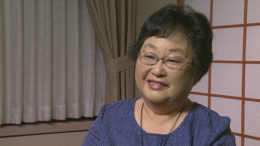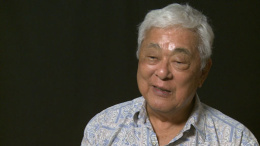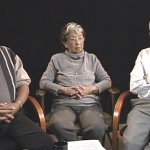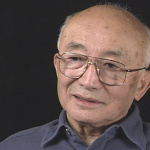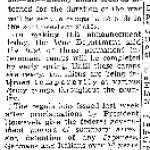Sand Island (detention facility)
| US Gov Name | Sand Island Internment Camp |
|---|---|
| Facility Type | U.S. Army Internment Camp |
| Administrative Agency | U.S. Army |
| Location | Sand Island, Oahu, Hawaii (21.3000 lat, -157.8833 lng) |
| Date Opened | December 1941 |
| Date Closed | March 1, 1943 |
| Population Description | Held people of Japanese descent, citizens and non-citizens, men and women; also held Austrian, Finn, German, Italian, Korean, and Norwegian nationals. |
| General Description | Located on a five-acre facility near Honolulu Harbor in Hawaii. |
| Peak Population | 300 |
| National Park Service Info | |
Nestled inside of Honolulu Harbor, this tiny coral island was rapidly transformed into a U.S. Army internment camp following the Japanese attack on Pearl Harbor. For the next fifteen months, the Sand Island facility served as the primary confinement site in the Territory of Hawai'i. At its peak, the camp held more than 450 local Hawai'i residents—including dozens of American citizens—as well as a few dozen Japanese prisoners of war. [1] By March of 1943, all civilian detainees were either transferred to continental camps or a new inland site at Honouliuli , partly due to concerns over to the Sand Island's vulnerable location. [2] Nevertheless, Sand Island reopened as a prisoner-of-war (POW) camp in 1945, holding Italian and Korean soldiers. [3]
Preparations and Initial Roundup
Federal officials identified Honolulu's Immigration Station and the nearby Territorial Quarantine Hospital on Sand Island early on as facilities suited for the confinement of civilians. Surgeon General Thomas Parran resisted Secretary of War Henry Stimson's May 1941 request to place the buildings under his jurisdiction in the event that "Army authorities are directed to take over internment of enemy aliens." [4] However, the Japanese attack on O'ahu, followed by Governor Joseph Poindexter 's declaration of martial law, caused the U.S. Army to forcibly seize the facilities on December 8. [5]
The mass arrest and confinement of local residents appearing on the Federal Bureau of Investigation's custodial detention list began immediately after the declaration of martial law on December 7, 1941. (See martial law, Hawai'i .) By December 10, FBI agents had apprehended 493 civilians, including forty-three American citizens and numerous neighbor island residents. [6] This initial group consisted mostly of Buddhist and Shinto priests, Japanese language school teachers, journalists, and toritsuginin , volunteer consular officials who helped local residents update their family registers in Japan. [7]
Those arrested on O'ahu were initially crowded into the Honolulu Immigration Station pending a hearing or a short boat ride to Sand Island. [8] Soldiers armed with bayonets led their charges to the building's basement, where they searched the inmates and confiscated their belongings. [9] Detainees were informed that hearings would be granted as a privilege rather than a right. Although they were permitted legal counsel, expenses were not covered and the defendants were not permitted to confront their anonymous accusers. [10] In many cases, a second panel of FBI, Military Intelligence Division (MID), and Office of Naval Intelligence (ONI) officials overruled a hearing board's initial recommendation for parole or release, resulting in the defendant's continued confinement. [11]
Camp Life
As many as 456 civilian detainees were packed into this five-acre camp, which was surrounded by a fifteen-foot fence ringed with barbed wire and eight twenty-foot-high guard towers. [12] Although the quarantine facilities already included a mess hall, administrative quarters, and a few housing units, the military expended half a million dollars on improvements. [13] The site was divided into four compounds—two for Japanese males, one for female detainees of "mixed race," and a final one for male Germans and Italians. [14] Since the completion of the barracks took more than two months, inmates initially slept on army cots in eight-person open-air tents. These cots were laid directly on the coral floor and the island was prone to flooding during heavy rains. [15] High school and college students from the Hawai'i Territorial Guard watched over a collection of community leaders that included medical doctors, architects, and school principals, as well as territorial legislators Sanji Abe and Thomas Sakakihara. [16]
The first two weeks of confinement on Sand Island were particularly severe. The weather was poor and few detainees had access to spare clothing, toothbrushes or razors. [17] Guards referred to their civilian charges as "POWs," subjecting them to a strip search on at least one occasion. [18] Detainee Alfred Preis recalled the indignity of being forced to clean toilets with his bare hands. [19] Roll calls—conducted twice a day, often during driving rain—tested the fortitude of Sand Island inmates, many of whom suffered from medical conditions. [20] Deprived of family visits, in addition to radios, newspapers, and wristwatches, the detainees spent the first two weeks in a state of imposed ignorance. [21] Tensions eased after a late December visit from Military Governor Delos Emmons , who stressed that the inmates were to be treated as "detainees" rather than POWs. [22]
By the time the International Red Cross and the Swedish Vice Consul inspected the camp in the fall of 1942, conditions had improved considerably. Inspectors praised Sand Island's barracks, kitchen, and cuisine, prepared by interned chefs from Waikiki's leading hotels. [23] Tents had been replaced with four two-story barracks in February, complete with separate quarters for female detainees. [24] Camp facilities included a laundry, latrines, mess halls, an infirmary, and an athletic field. [25] Detainees were divided into companies and they elected representatives to serve as conduits to camp authorities. [26] Family visits were allowed twice a month from May 1942 onwards, helping to lift detainees' spirits. [27]
As time crept forward, inmates developed a variety of strategies for combating their perpetual boredom. Mail was eventually permitted, but letters were censored and had to be written in English. [28] Sundays provided a welcomed escape from monotony, as detainees gathered together for an assortment of religious services, with men and women intermingling freely. [29] In between, the residents of Sand Island busied themselves with crafts—coral artwork was a favorite pastime—gardening, and camp chores, including laundry, kitchen duties, and picking up loose trash. [30]
Camp Closure
The Sand Island camp served as the principal transfer and holding site for Hawai'i's civilian detainees for fifteen months. However, the island's location in an exposed combat zone put the detainees at risk and generated concerns among officials. [31] Shipments of Sand Island inmates to the U.S. mainland for prolonged confinement commenced in February 1942 and continued until the closure of the civilian camp in March 1943. By that point, more than six hundred local residents from across the Hawaiian Islands had passed through Sand Island on their way to continental camps. [32] The 149 remaining detainees were taken to a new facility in the Honouliuli gulch in early March 1943. [33] Two years later, as prisoners arrived from the European and Pacific theaters, Sand Island was converted into a POW camp. By September 1945 the site held 1,010 Koreans and 952 Italians. [34] Today Sand Island is home to a state recreation area, a U.S. Coast Guard base, a wastewater treatment facility, and an assortment of industrial facilities, but no evidence of the wartime detention center remains.
For More Information
Commission of Wartime Internment and Relocation of Civilians. Personal Justice Denied: Report of the Commission on Wartime Relocation and Internment of Civilians . Seattle: University of Washington Press, 1997.
Kashima, Tetsuden. Judgment Without Trial: Japanese American Internment during World War II . Seattle: University of Washington Press, 2004.
Miyamoto, Kazuo. Hawaii: End of the Rainbow . Rutland, VT: Tuttle Company, 1964.
Soga, Yasutaro (Keiho). Life Behind Barbed Wire: The World War II Internment Memoirs of a Hawai'i Issei . Honolulu: University of Hawai'i Press, 2008.
Footnotes
- ↑ Daily commanding officer's reports, indicating the number of detainees and POWs, can be accessed at the National Archives and Records Administration (hereafter cited as NARA), Record Group (hereafter cited as RG) 494, Entry 25, Boxes 334 and 336. See also Provost Marshal Section, "Vital Statistics: POW Compounds, Prisoners of War, and Internees in Hawaiian Islands," Japanese Cultural Center of Hawai'i Resource Center, Archival Collection 19 (hereafter cited as JCCH 19), Box 9, Folder 30.
- ↑ The Swedish Vice Consul, Gustaf Olson, who inspected the camp, was among those who officially expressed concerns that civilians were being confined in an exposed combat zone. See "Letter from Swedish Vice Consul in Hawai'i," 28 November 1942, in JCCH 19, Box 8, Folder 57. These concerns are also discussed in Jeffrey F. Burton and Mary M. Farrell, "Jigoku-Dani: An Archaeological Reconnaissance of the Honouliuli Internment Camp, O'ahu, Hawai'i" (Tucson: Trans-Sierran Archaeological Research, 2008), 11.
- ↑ See Provost Marshal, "Vital Statistics." For further details on Sand Island POWs, see Jeffrey F. Burton and Mary M. Farrell, "World War II Japanese American Internment Sites in Hawai'i (Tucson: Trans-Sierran Archaeological Research, 2007), 49-51.
- ↑ See Henry L. Stimson, "Requesting Use of Ala Moana Immigration Station and Sand Island Facilities for Internment," 9 May 1941, JCCH 19, Box 5, Folder 29; and Thomas Parran, "Public Health Position on Use of Quarantine and Sand Island Facilities," DATE, JCCH 19, Box 5, Folder 31.
- ↑ See "Hawai'i Taking Emergency Action to Construct Sand Island," JCCH 19, Box 5, Folder 43; "Reports Giving Quarantine Station to Army," JCCH 19, Box 5, Folder 28; and "Transmitting Letter of Irrevocable License to Army for Immigration Building and Area," JCCH 19, Box 5, Folder 29. For more on the relationship between martial law and internment in wartime Hawai'i, see Commission of Wartime Internment and Relocation of Civilians, Personal Justice Denied: Report of the Commission on Wartime Relocation and Internment of Civilians (Seattle: University of Washington Press, 1982), 263, 266-268.
- ↑ This number comes from Commission, Personal Justice Denied , 264. For similar figures, see Tetsuden Kashima, Judgment Without Trial: Japanese American Internment during World War II (Seattle: University of Washington Press, 2004), 72. Gwenfread Allen reports 482 people taken into custody on the island of O'ahu alone by December 10. See Gwenfread Allen, Hawaii's War Years (Kailua: Pacific Monograph), 42. See also Burton and Farrell, "Internment Sites in Hawai'i," 43. For a complete list of the ethnic Germans and Italians detained in Hawai'i through the first three months of martial law, see R.L. Shivers, "Letter to Director of Federal Bureau of Investigation" and accompanying lists, 6 February 1942, Freedom of Information Act (FOIA) file 100-2-200. (File provided by Doris Berg Nye.) For more on the initial wave of arrests in Hawai'i, see also Allen, War Years , 39; Dorothy Ochiai Hazama and Jane Okamoto Komeji, Okage Sama De: The Japanese in Hawai'i, 1885-1985 (Honolulu: Bess Press, 1986), 123-125; Commission, Personal Justice Denied , 263-264; and Kashima, Judgment Without Trial , 69-73. For a detailed account of civilian internment on the island of Kaua'i, see Alan Rosenfeld, "'An Everlasting Scar': Civilian Internment on Wartime Kaua'i," in The Hawaiian Journal of History 45 (forthcoming, 2011).
- ↑ See Shivers, "Letter to FBI Director," 4 December 1941; Kashima, Judgment Without Trial , 72; Burton and Farrell, "Jigoku-Dani," 10.
- ↑ Stephen Fox, Fear Itself: Inside the FBI Roundup of German Americans during World War II (Lincoln: iUniverse, 2007), 11, 39-40; Yasutaro (Keiho) Soga, Life Behind Barbed Wire: The World War II Internment Memoirs of a Hawai'i Issei (Honolulu: University of Hawai'i Press, 2008), 26; Kazuo Miyamoto, Hawaii: End of the Rainbow (Rutland, VT: Tuttle Company, 1971), 304-314. For the precise numbers of detainees at the Honolulu Immigration Station—often numbering more than 100—see commanding officer's reports in NARA, RG 494, Entry 25, Box 336. For a more extensive discussion of the Immigration Station as a confinement site, see Burton and Farrell, "Internment Sites in Hawai'i," 45-46.
- ↑ Soga, Barbed Wire , 26; For testimony regarding the use of bayonets, see Miyamoto, Hawaii , 311; Alfred Preis, "Interned: Experiences of an 'Enemy Alien,'" in Michi Kodama-Nishimoto, Warren Nishimoto, and Cynthia Oshiro, eds., Talking Hawai'i's Story: Oral Histories of an Island People (Honolulu: University of Hawai'i Press, 2009); and Jukichi Inouye, interview by Japanese-American Resource Center, tape recording, 'Ele'ele, HI, 12 November 1982, Hawaiian War Records Depository, Archives & Manuscripts Department, University of Hawai'i at Manoa (hereafter cited as HWRD), Japanese Internment and Relocation: The Hawai'i Experience, no. 236.
- ↑ For more information on Hawai'i hearing board procedures, see hearing board transcripts from individual case files in NARA, RG 389, Entry 461; Kashima, Judgment Without Trial , 73-74; Tetsuden Kashima, "Introduction," in Soga, Barbed Wire, 5-6; Miyamoto, Hawaii , 335-353.
- ↑ Many examples of this can be found in individual hearing board transcripts in NARA, RG 389, Entry 461.
- ↑ For references to the camp size, see Kashima, Judgment Without Trial , 74; and Miyamoto, Hawaii , 314; For references to the barbed-wire enclosures, in addition to these two sources, see Soga, Barbed Wire , 36; and Stephen Fox, America's Invisible Gulag: A Biography of German American Internment and Exclusion in World War II (New York: Peter Lang, 2000), 79. For more on the guard towers, see Burton and Farrell, "Internment Sites in Hawai'i," 49.
- ↑ "U.S. Army Forces Middle Pacific and Predecessor Commands During World War II: Chapter IX: Prisoners of War," JCCH 19, Box 9, Folder 39. See also Burton and Farrell, "Internment Sites in Hawai'i," 49.
- ↑ For more on the camp's division into separate compounds, see "U.S. Army Forces." In actuality, Sand Island's "German" inmates including aliens and U.S. citizens of Austrian, Danish, Finnish, Swedish, Lithuanian, and Irish ancestry. For the ethnic make-up of Sand Island's "mixed" and "German" detainees, see individual hearing board transcripts in NARA, Record Group 389, Entry 461. See also Burton and Farrell, "Internment Sites in Hawai'i," 48; and Miyamoto, Hawaii , 324.
- ↑ For more detailed discussions of conditions on Sand Island, including flooding, see Miyamoto, Hawaii , 314-345; Soga, Barbed Wire , 29-65; Kashima, Judgment Without Trial , 74-85; Fox, Invisible Gulag , 79, 81, 228; Nishimoto-Kodama, Talking Hawai'i's Story, 230-238; Burton and Farrell, "Jigoku-Dani," 11; and Susan Morrison and Peter Knerr, "Forgotten Internees," Honolulu Magazine (November 1990), 108-109.
- ↑ The Territorial Guard was formed from the University of Hawai'i ROTC shortly after the Pearl Harbor attack. See, Miyamoto, Hawaii , 316-317. Note: Miyamoto refers to it as the "Honolulu Home Guard." Sakakihara was arrested in February 1942 and Abe in August 1942, but both were interned on Sand Island.
- ↑ See Soga, Barbed Wire , 32; and Fox, Invisible Gulag , 81.
- ↑ For more on the incorrect POW designation, see Soga, Barbed Wire , 29. For more discussions of strip searches, see Soga, Barbed Wire , 31; and Kashima, Judgment Without Trial , 75.
- ↑ Interview with Preis in Kodama-Nishimoto, Talking Hawai'i's Story , 232.
- ↑ For more on the roll calls, see Soga, Barbed Wire , 30-34; and Kaetsu Furuya, interview by Japanese-American Resource Center, tape recording, Honolulu, HI, 11 November 1982, HWRD, Japanese Internment and Relocation: The Hawai'i Experience, no. 233, 2-3. Furuya claimed that the roll calls caused the death of Kaua'i resident Hisahiko Kokubo Takara, who perished at the Sand Island camp in March 1942. See "Sand Island death of Hisashi Kokubo," in JCCH 19, Box 3, Folder 61.
- ↑ See Soga, Barbed Wire , 31, 35-36, 61, 64. Soga claims that Sand Island detainees were not allowed family visits until after May 25, 1942.
- ↑ Soga, Barbed Wire , 32; and Miyamoto, Hawaii , 328-329.
- ↑ See Olson, "Letter," 28 November 1942; and Sociétés de la Croix Rouge, "Detention Camp Sand Island" in Revue Internationale de la Croix-Rouge: Bulletin International des Sociétés de la Croix Rouge 25 no. 291 (March 1943), 213, JCCH 19, Box 7, Folder 23. For more on interned chefs, see Miyamoto, Hawaii, 324; and Kodama-Nishimoto, Hawai'i's Story , 236-237.
- ↑ See Soga, Barbed Wire , 47; and "U.S. Army Forces."
- ↑ For discussions of facilities at the Sand Island Camp, see Burton and Farrell, "Internment Sites in Hawai'i," 46-51; Kashima, Judgment Without Trial , 74-75; Soga, Barbed Wire , 29-65; Kodama-Nishimoto, Hawai'i's Story , 234-237; and Miyamoto, Hawaii , 314-257.
- ↑ Soga, Barbed Wire , 30.
- ↑ See Soga, Barbed Wire , 61.
- ↑ Soga, Barbed Wire , 34.
- ↑ See Soga, Barbed Wire , 47; and Knerr and Morrison, "Forgotten Internees," 109.
- ↑ For more on detainees' activities inside the camp, see Miyamoto, Hawaii , 319-321, 330; Soga, Barbed Wire , 31, 35-36; and Knerr and Morrison, "Forgotten Internees," 109.
- ↑ Olson, "Letter," 28 November 1942.
- ↑ Soga, Barbed Wire , 226. Sailing lists can be accessed in NARA, RG 494, Entry 25, Box 334.
- ↑ See commanding officer's report, 4 March 1943, NARA, RG 494, Entry 25, Box 334.
- ↑ See Provost Marshal, "Vital Statistics."
Last updated July 22, 2020, 3:54 p.m..

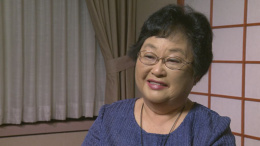 Media
Media
